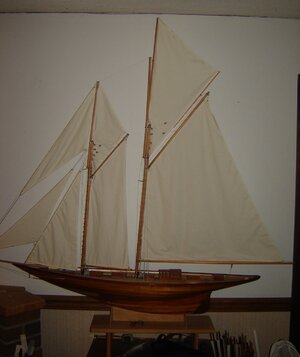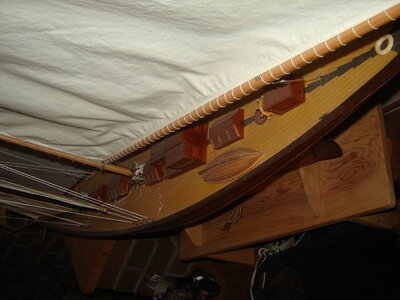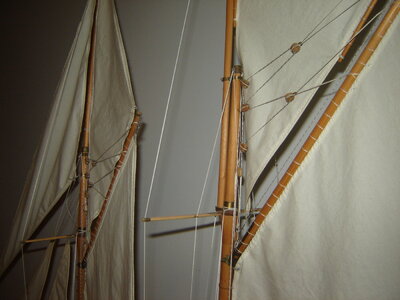About fifteen years ago I "scratch" built an POB RC version of the Cicely, an early 20th century schooner. The original had composite construction, iron frame with wooden planking. How would you go about truly scratch building something like that?
-
LUCZORAMA SHIPWRECK SCAVENGER HUNT GIVEAWAY. 4 Weeks of Fun • 1 Legendary Prize ((OcCre’s Fram Ship)) • Global Crew Welcome!
**VIEW THREAD HERE**
You are using an out of date browser. It may not display this or other websites correctly.
You should upgrade or use an alternative browser.
You should upgrade or use an alternative browser.
The inner construction is not being seen. Cannot the frame be replaced with wooden or anything construction?
Yes, but then it's not what I would consider a full blown "Scratch build"
...then it is pretty much only one choice. You will have to build an iron frame and use composite constructions. Also, you may consider using the timbers actually used for the build. To better help you with your question\s, can you define a 'full-blown' scratch build?Yes, but then it's not what I would consider a full blown "Scratch build"
As close to the real thing as possible. So I would have to make iron frames or at least a reasonable facsimile. That's basically what I was looking for. I'm wondering if someone has done this before or if this kind of construction is avoided like the plague. I'm not sure if I can build it anyway. When I built it I contacted the Scottish maritime Museum and all they had was the deck plan. I got the lines from a picture of a picture in a magazine.
So the real question is: will you keep your frames open? Then, it makes sense to made frames the way they are built. We do have many modelers on this forum making POF (Plank On Frames), where frames are built the way on the actual ships.As close to the real thing as possible. So I would have to make iron frames or at least a reasonable facsimile. That's basically what I was looking for. I'm wondering if someone has done this before or if this kind of construction is avoided like the plague. I'm not sure if I can build it anyway. When I built it I contacted the Scottish maritime Museum and all they had was the deck plan. I got the lines from a picture of a picture in a magazine.
I guess I don't explain myself well, sorry. What I'm wondering about is if composite ships are often modeled and if so how do they make the frames.
I know only section models to show the typical structure of composite hullsI guess I don't explain myself well, sorry. What I'm wondering about is if composite ships are often modeled and if so how do they make the frames.
something like this?
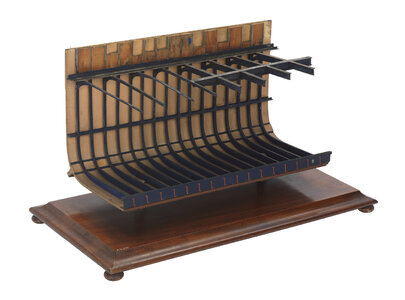
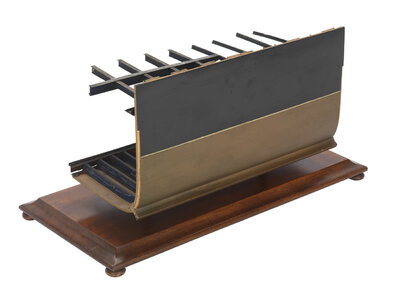
Sectional model; Frame model
Scale: Unknown. A sectional model showing the iron frames of a composite-built ship. The model shows sixteen iron frames that form the floor and side of a ship's hull, connecting frames, iron deck beams, wooden filling frames and the completed outer hull. The exterior hull has been painted in realistic colours dark ochre below, black above, divided by a fine white line. The model also shows a section of bilge keel. The iron frames are painted blue and the model is annotated in various places, "A", "B", "D", "E", "F", "G", "K". The model is mounted on two turned brass pillar supports which are secured to a rectangular polished mahogany baseboard with bevelled edges and standing on four bun feet.Sectional model; Frame model | Royal Museums Greenwich
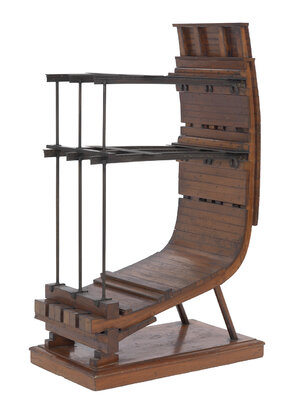
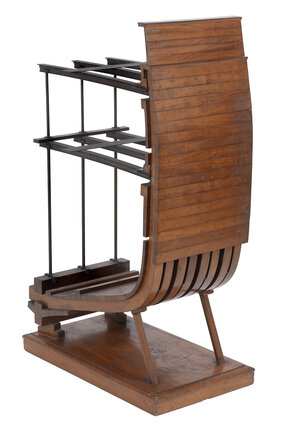
Highflyer (1851)
Scale: 1:8. A model of the half midship section of the clipper ship Highflyer (1851) made in wood and metal. The lower hull to just below the waterline has been constructed in wood with a section of planking removed to show the disposition of the frames. Above this area a large section of hull planking has been fixed right up to the level of the bulwark and capping. Internally the model shows a keelson, ceiling planks, deck beam shelves and spirketting, all of which are stained in a dark mahogany and varnished. The deck pillars, beams and a small section of deck plating are made in metal and illustrate the method of fitting these components to the wooden hull by a series of metal knees. The whole model is mounted on a pair of wooden keel blocks and further supported by a pair of angled wooden, octagonal-shaped props at the turn of the bilge, all of which are secured to a large wooden rectangular baseboard finished with a moulded edge.Highflyer (1851) | Royal Museums Greenwich
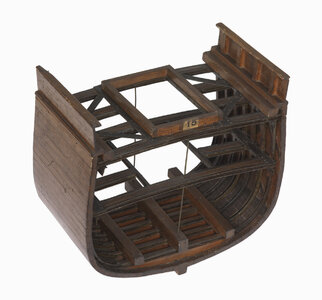
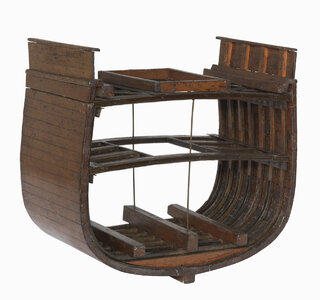
Sectional model; Midship model
Scale: Unknown. A midship model showing a proposed method of hull construction with double-rigged iron frames and wooden planking. The model is made largely in wood with a planked hull and wooden frames to the upperworks. Two decks are depicted in frame, the main deck having a large hatch with a wooden edge. The deck beams are composite with wooden beams sandwiched between metal beams and with metal diagonal bracing. The deck below is identical in terms of composition and layout, but without the diagonal bracing. Two slender metal supports run vertically at either end of the section, fore and aft of the hatches, and terminating at the keelson. A paper label has been applied to the edge of the main deck hatch frame marked "15".Sectional model; Midship model | Royal Museums Greenwich
Don, if you desire to simulate the iron/steel frames in a scratch build, you can consider using styrene. It comes in several forms from sheet to el's to I's. With warm/hot water you can bend them to you specifications. Then paint with a metallic or black or rusty paint. Just a thought.
I think you can buy scale I-Beams and iron in scale from places like micromark and I am sure there are other "architectural" supplies as this would be something in demand. I would google scale steel strucutres parts. and see if there are some scale items like this. I know I have seen BRASS I-Beams, BRASS square tubes that come in many shapes and sizes and then you can blacken them. I am not sure if I am any help and maybe I am not understanding. But the point is that you can buy scale steel structural parts.
here is a typical link I found
 www.modeltrainstuff.com
www.modeltrainstuff.com
 kitkraft.com
kitkraft.com
 oakridgestores.com
oakridgestores.com
here is a typical link I found
Layout - Supplies - Scratch Building - Bars, Beams, Columns & Trusses - Page 1 - ModelTrainStuff
Expand your model train layout from scratch with bars, beams, columns, and tresses. Model Train Stuff is a top online store for railroaders.
 www.modeltrainstuff.com
www.modeltrainstuff.com
ABS Plastic Materials for Model Building - Kit Kraft
Durable ABS plastic materials for building architectural models, prototypes and sculptures at Kit Kraft. Large selection of ABS plastic tubes, beams and more.
ALL SCALES Structural - Beams, Truss, Columns
ALL SCALES Structural - Beams, Truss, Columns. Plastruct ABS Plastic Scale Structural Beams, Truss, Columns, Scale Modeling, Scale Structural Components including roof truss, floor truss, webb truss, trusses, channels, columns, I beams, h beams, c beams and footers for the architect, engineer...
Last edited:
Thank you both. very helpful



